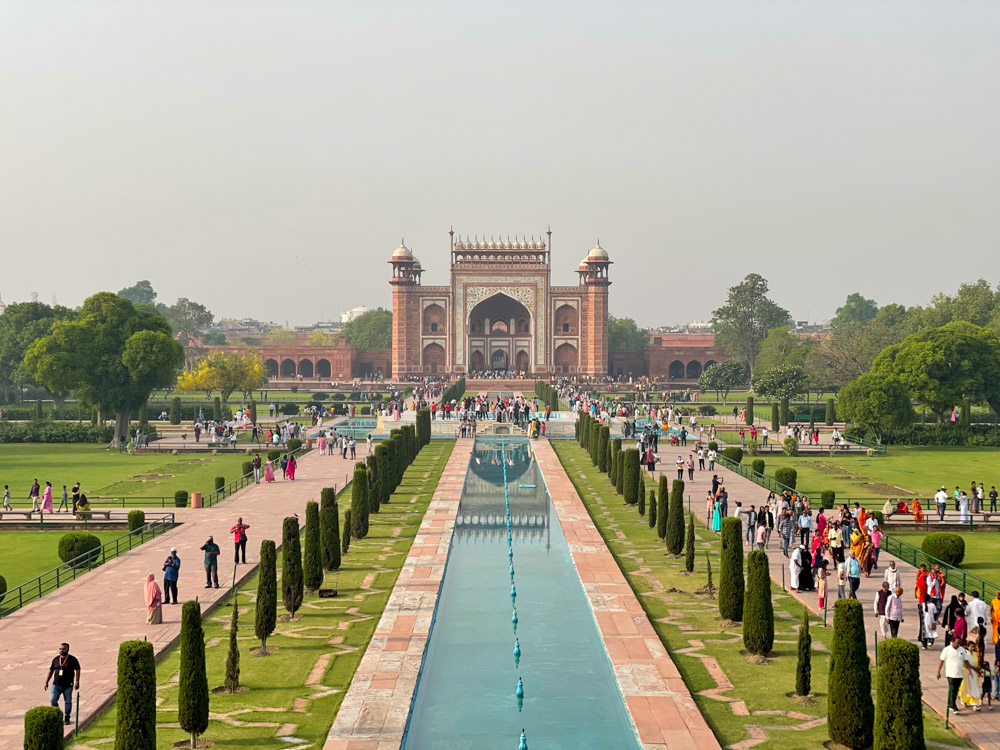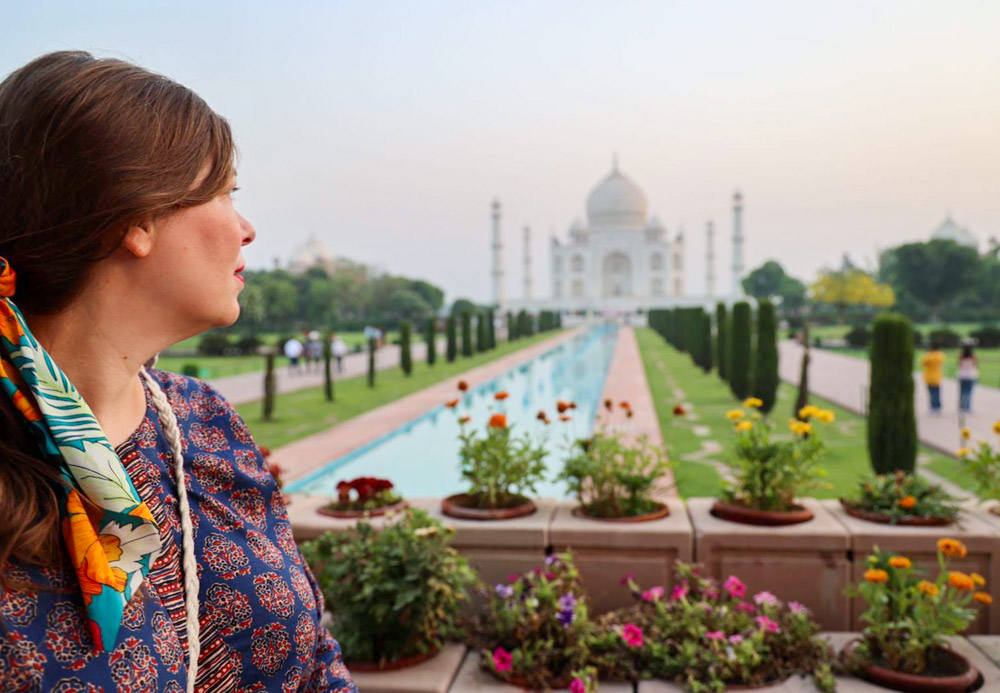Located in Agra, India, the Taj Mahal is an incredible UNESCO World Heritage Site included in the Seven Wonders of the Modern World. Every day, thousands of tourists flock to this iconic site to enjoy its beauty and grandeur. Built in 1653 by Emperor Shah Jahan in memory of his beloved wife Mumtaz Mahal who died in childbirth, the Taj Mahal enchants visitors with its extraordinary beauty and romantic history.
Table of Contents
Taj Mahal in Agra: a legacy of love and beauty
The Taj Mahal, one of the world’s most fascinating architectural wonders, is located in the heart of India, in the state of Uttar Pradesh. This monument is much more than an imposing white marble structure. A symbol of eternal love, it is a masterpiece of Mughal architecture. And a must-see destination for travellers from all over the world, of course.
PLAN YOUR TRIP TO INDIA
When in India, stay connected at the best rates by purchasing an Airalo eSIM online before your trip. This eliminates the hassle of purchasing a physical SIM at the airport.
About travel insurance, Heymondo is the way to go. They offer comprehensive coverage against unexpected events like medical emergencies, trip cancellations, lost luggage, and more. Heymondo provides excellent value for money and will give you peace of mind on your travels!
The history of the Taj Mahal is inextricably linked to its protagonists. A funeral monument built by the Mughal emperor Shāh Jahān to forever remember his beloved wife Arjumand Banu Begum, better known as Mumtāz Maḥal.
Their love affair began with a thunderbolt during a monthly women’s market. Unfortunately the emperor was already betrothed to another woman from the royal family in an arranged marriage. Despite the complicated situation, the emperor managed to marry the woman he had fallen in love with. Together they spent eighteen happy years.
Their idyll was interrupted by the untimely death of Mumtāz Maḥal, who died during the delivery of their fourteenth child. Emperor Shāh Jahān entered a state of deep sadness. He only recovered when he dreamt of his wife in paradise so he decided to replicate his dream on earth to remember her. That is the reason why the Taj Mahal was built.
In the Taj Mahal the two loved ones rest side by side. The entire mausoleum complex has become a symbol of eternal love and timeless beauty. Visiting it is a unique experience, and discovering the history behind this architectural marvel is even more fascinating. The Taj Mahal is more than just a tourist attraction. Its spectacular architecture, a UNESCO World Heritage Site for its incredible beauty, leaves visitors speechless.

The architecture of the Taj Mahal: an incomparable artistic masterpiece
To cross the threshold of the Taj Mahal complex is to enter a timeless place. Its beauty will leave you breathless. Every detail is taken care of. It truly looks like heaven on Earth. At the centre of it all the mausoleum dedicated to the beloved Mumtāz Maḥal, wife of the Mughal emperor Shāh Jahān.
In the Taj Mahal, beauty and history come together in an extraordinary experience thanks to its architectural harmony. All the facades of the mausoleum are identical, topped by a majestic central double dome, with a pinnacle that adds a further 30 metres of height to the structure. The outer dome has mainly a decorative function, while the inner dome protects the royal tombs.
External garden
The building is surrounded by a garden with ponds that contribute to an atmosphere of peace and devotion. Initially designed in a Persian style and adorned with cypress trees, the garden was later enlarged. The lawn in fact was added during the colonial period. Walking through these well-kept gardens will make you feel as if you are walking through a living work of art.
Twin mosques
On each side of the Taj Mahal, twin mosques enhance the overall symmetry and harmony of the composition. These mosques mirror the style of the main entrance gate, featuring floral decorations with motifs identical to those inlaid on the mausoleum’s outer walls.
Taj Mahal decorations
While the Taj Mahal may leave you speechless from a distance, its intricate details up close are truly astonishing. The facades are adorned with colored marble inlays and precious stones on white marble, forming intricate patterns of lines and verses from the Koran. Additionally, you’ll find carved flowers and floral details inspired by the mosques’ facades. The inlays predominantly use malachite and lapis lazuli, creating captivating plays of color and light that vary with the sun’s angle.
Mughal emperor and his wife’s graves
Although the Taj Mahal is universally recognised as a symbol of eternal love, it is essentially a mausoleum. Inside the main structure, you’ll find a second identical inner building encircled by corridors. This inner building contains replicas of the tombs of Emperor Shāh Jahān and his beloved consort Mumtāz Maḥal. The original tombs are in fact located in an underground level open to the public only once a year.

Practical Information for Visiting the Taj Mahal Mausoleum
The Taj Mahal stands as one of India’s most frequented destinations, welcoming an average of 22,000 tourists daily. To make the most of your visit and escape the crowds, I recommend planning your trip in the early morning at dawn when the complex opens. This allows you to appreciate the Taj Mahal in optimal lighting and avoid the congestion of peak hours.
Also, if possible, consider avoiding visiting during the peak tourist season, when the Taj Mahal can be particularly crowded. Visiting the monument during the off-season can offer you a quieter and less chaotic experience.
In contrast to numerous other tourist sites in India, the Taj Mahal complex is distinguished by its cleanliness and absence of litter. However, you’ll still encounter souvenir sellers right up to the complex threshold, where they are not permitted. Once inside, dedicate some time to appreciate the architectural details and decorations of the Taj Mahal. Each sculpture, inlay, and motif carries a unique story, inviting you to immerse yourself in the beauty and history of this extraordinary place.
Clothing and precautions for a visit to the Taj Mahal
When planning your visit to the Taj Mahal, there are a few considerations to keep in mind to have a positive experience, despite the popularity of the destination. First, make sure you wear light clothes for the temperatures, but not shorts or tank tops. The mausoleum is still a place of worship and could be disrespectful.
Also, comfortable shoes are essential for exploring the complex. Inside the mausoleum, when visiting the royal tombs, you will be asked to wear shoe covers to preserve the marble from wear caused by visitors.
Given the high temperatures in India and the vast outdoor spaces to traverse, it is essential to bring a good supply of water with you to visit the Taj Mahal. Keeping yourself hydrated will help you get through your visit to this extraordinary architectural complex. Also, watch out for mosquitoes, which are particularly aggressive. Take an insect repellent with you to avoid annoying bites.
Security checks at the entrance
Before entering the Taj Mahal, you have to go through security checks at the entrance, like those at the airport. During high season, you may have to wait up to half an hour before you can enter the Taj Mahal, due to queues. During low season, however, entry is faster. Inside the complex, you may not bring drones, sharp objects, food or drinks, except water.
After passing through security, you can reach the mausoleum complex by golf cart or on foot. Golf carts are very convenient, but only leave when the seats are fully occupied. The area between the ticket office and the Taj Mahal is home to many souvenir shops. They are still closed at dawn in the morning. This could be an advantage if you prefer a quiet visit, without being intrusive by souvenir sellers.
Opening hours and ticket price
The Taj Mahal complex is open every day except Fridays, with first entry about 30 minutes before sunrise and closing 30 minutes before sunset, so times may vary. Arriving early allows you to avoid the crowds and admire the beauty of the monument at dawn.
Ticket prices vary according to nationality. Indian citizens can enter the Taj Mahal for about INR250, while foreign tourists pay about INR1,300, about €15/£13 at the time of writing. The queues at the ticket office are also divided between Indians and foreigners. Children and young people under 15, on the other hand, get in for free regardless of nationality.
Unless you are with a group and your guide takes care of the tickets, it is best to buy Taj Mahal entrance tickets online to avoid the queues at the ticket office and save money. In fact, online tickets are cheaper than tickets bought locally.
Where the Taj Mahal is located
The Taj Mahal is located in the city of Agra in the state of Uttar Pradesh, India, and is easily accessible from different parts of India. From Delhi, the capital of India, you can reach Agra with an organised tour to the Taj Mahal and Agra from Delhi, or by train or car and then travel by tuk-tuk or taxi. Once in Agra, in addition to the Taj Mahal, I recommend a visit to the nearby Agra Fort, a UNESCO World Heritage Site known for its majestic architecture.
Taj Mahal
Dharmapuri, Forest Colony, Tajganj
Agra, Uttar Pradesh 282001
With this information you can plan your visit to the Taj Mahal, a must-see destination on a trip to India. Write to me in the comments if you have already had the opportunity to visit this marvel or if it is part of your next travel destinations.
